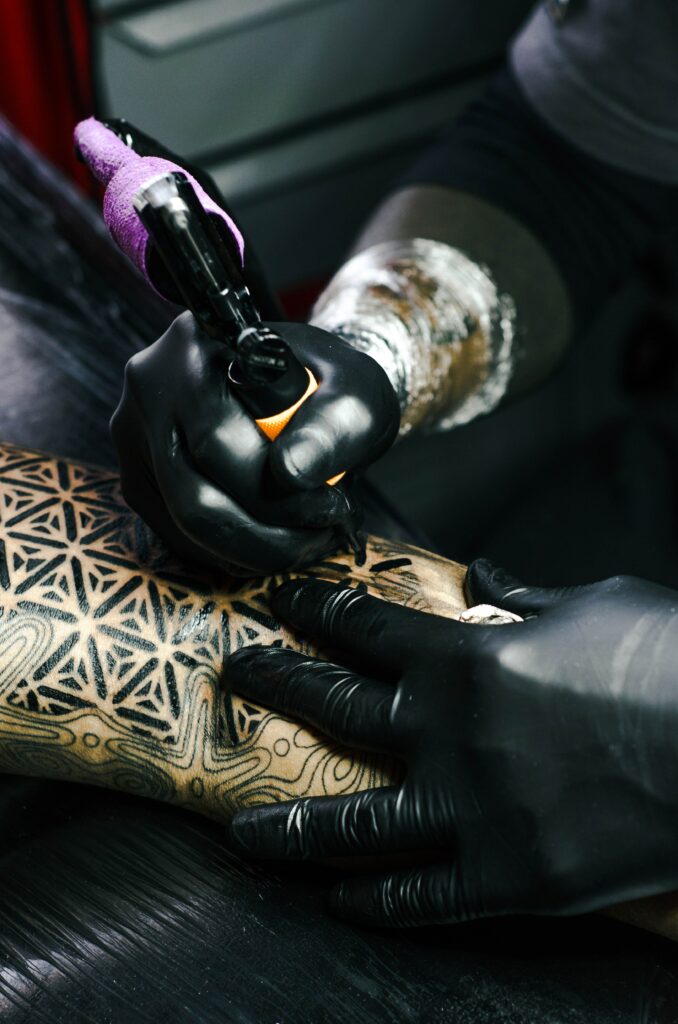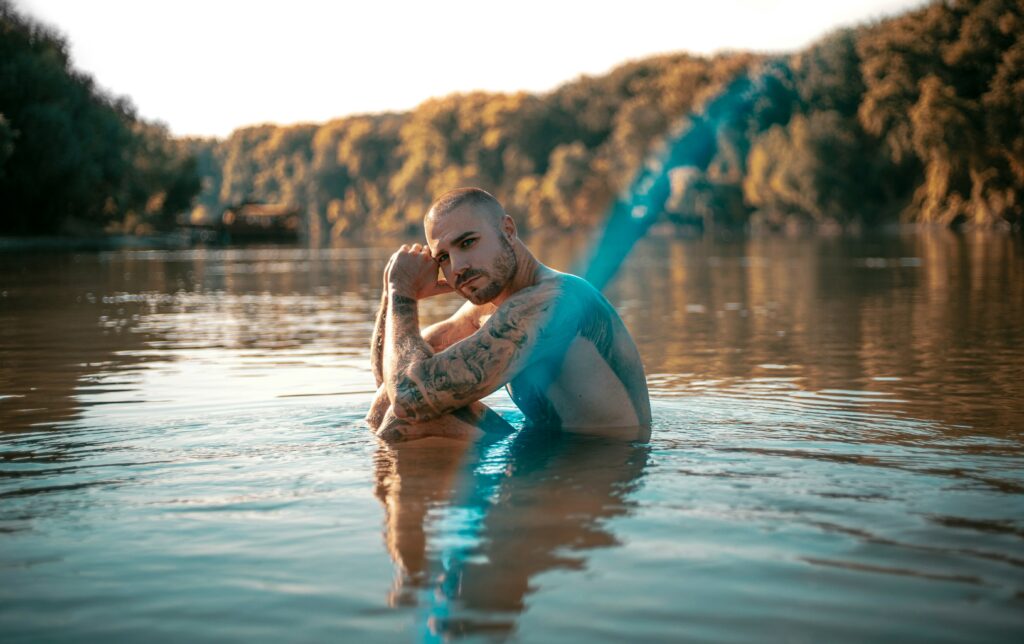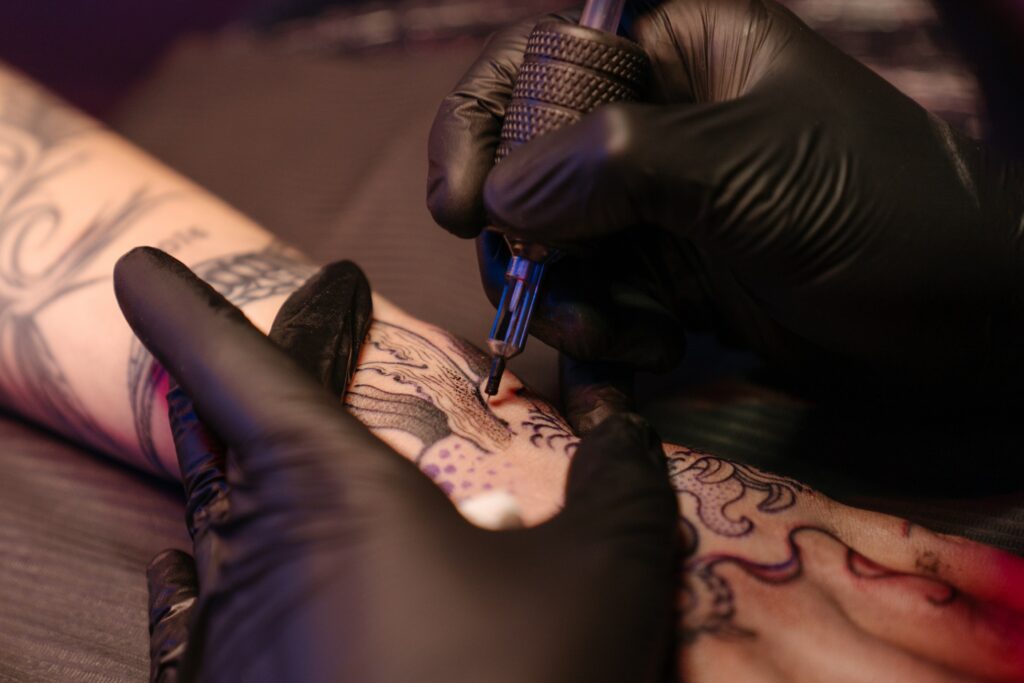Table of Contents
This post is your life-raft in the sea of misinformation about tattoos and aquatic adventures. By the end of this nautical journey, you’ll have learned the dos and don’ts of navigating your freshly tattooed body through any body of water – be it a chlorinated pool, a salty sea, or your own comforting hot tub.

Consider this a splash course (couldn’t resist the pun!) that will take you from floundering to fluent in understanding the critical dance between ink healing and water immersion. I’ll be providing you with the basic facts, backed by years of experience, a dash of science, and my well-earned knowledge in the vibrant world of tattoos.
So, get ready to dive in as we unravel this mystery and learn how to keep our tattoos vibrant and our bodies healthy. Remember, every tattoo is a testament to your life story, and I’m here to ensure your stories remain as vivid and lively as the day they were inked. Let’s set sail, shall we?
Ink Meets Water: The Swimmer’s Guide to Tattoo Care

Whether you’re a seasoned ink aficionado or a tattoo newbie about to get your first piece, you’ve probably come across a flurry of advice about tattoo aftercare, especially regarding water activities. Not to worry, I’ve got you covered! This guide will sail you through the turbulent sea of tattoo myths and facts, all while sharing a few of my own tattoo tales along the way.
Can you swim with an unhealed tattoo?
Fresh tattoos and bodies of water have a notorious love-hate relationship. One time, a friend of mine decided to ignore this rule and dove into a lake the day after a tattoo session. Not only did the beautiful bird on her arm turn into a colorful blotch, but she also ended up with a nasty infection. Ouch!
Here’s the reality: fresh tattoos are similar to open wounds. When you expose them to water bodies such as oceans, ponds, chlorinated pools, and even hot tub showers, you’re inviting harmful bacteria to an open party, leading to infections and potentially damaging the vibrant appearance of your new ink.
After what period of time can you start swimming?
Opinions vary, but the safe consensus, backed by the American Dermatologists Association, suggests a waiting period of 4-6 weeks before you can swim again post-tattooing. During this period, your skin heals, and your artwork settles into its permanent form. However, if you spot any signs of infection like redness, blisters, or itching, hold off on your water exploits until your tattoo is completely healed.
The consequences of swimming with a fresh tattoo

Ignoring the above advice can sink your tattoo experience quickly. Here’s how:
- Infections: Like I mentioned earlier, a fresh tattoo is an open invite to bacteria. Swimming in any water source can lead to a pesky infection causing fever, pain, and pus, thereby prolonging your tattoo’s healing process.
- Irritation: Imagine dipping sensitive skin into a pool filled with chlorine and other disinfectants. Yep, not a fun sight. Rashes, itching, and other forms of discomfort can quickly follow.
- Faded and Distorted Art: Prolonged exposure to hot water, chlorinated, or salt water can lead to loss of pigment and potentially affect the shape and color of your tattoo.
What if you accidentally wet a new tattoo?
So, you accidentally splashed some water on your new tattoo? Not a big deal! Simply rinse the tattoo with warm running water and antibacterial soap, then pat dry gently with a paper towel. Remember, the faster you remove the moisture, the better.
What about taking a shower?
Showering post-tattoo is different from swimming. You definitely should shower, but with some caution:
- Your tattoo artist will guide you on the right time to shower after your session. This can vary based on the tattoo size and the type of bandage used.
- Remember to avoid scrubbing the tattooed area to prevent skin damage.
- Use a gentle, fragrance-free antibacterial soap to keep your skin clean and avoid irritation.
- Don’t blast the water stream directly on your new tattoo, and try to keep the area as dry as possible.
- Shaving a fresh tattoo? A big no-no! This can damage the skin and increase the risk of infection.

How to find out that the tattoo has already healed and swimming is allowed?
Identifying a fully healed tattoo isn’t rocket science. Look out for the following signs:
- Smooth Texture: The texture of the tattooed skin should match the texture of your non-tattooed skin. If the area feels smooth and free of any scabs or rough patches, it’s a good sign that it has healed.
- No Peeling or Scabs: During the healing process, it’s normal for the tattoo to peel and even scab a bit. However, once these signs have disappeared, it indicates that the tattoo is healed.
- Vibrant and Clear Appearance: A fully healed tattoo should look vibrant and clear. There shouldn’t be any cloudiness, faded spots, or blurred lines.
- No Discomfort: If you can touch the tattooed area without any discomfort, it’s another indication of healing. There should be no tenderness, itchiness, or burning sensation.
- No Swelling or Redness: Any swelling, redness, or inflammation should have completely subsided when the tattoo is fully healed.
Though some tattoos might heal faster, it’s always best to wait for the recommended 4-6 weeks before swimming. And don’t forget to moisturize and apply SPF 30+ sunscreen regularly even after your tattoo has healed.
How Long Before You Can Use A Hot Tub After Getting A Tattoo?
Basically it is the same advice as above. It is recommended to wait at least 4-6 weeks before submerging your new tattoo in any water body, including hot tubs. The issue with hot tubs, in particular, is they pose additional risks due to the hot water and the chemicals often used to treat the water. The high temperature can cause your pores to open up, potentially causing the tattoo’s ink to fade or blur, while the chemicals may cause irritation or infection. It’s always better to err on the side of caution and give your tattoo the time it needs to fully heal before hopping into a hot tub or any similar environment.
Tips on how to speed up the healing process
- Prep Your Body: Hydrate, limit smoking and alcohol, and eat healthily before and after your tattoo session.
- Keep it Clean: Regularly clean the tattoo area with warm water and mild antibacterial soap.
- Use Healing Ointments: Quality tattoo ointments can promote faster healing and keep your ink vibrant.
- Wear Loose Clothing: This helps to avoid irritating the tattoo and promotes faster healing.
- Limit Physical Activity: Reducing sweat exposure can help prevent infection.
- Shield from the Sun: Avoid direct sunlight on the tattoo during the healing process.

So, there you have it, folks! A full rundown on the dos and don’ts of swimming post-inking. Remember, every splash into the water is a potential ripple on your tattoo. So tread with caution, and happy healing!
Suncreams & Moisturisers To Consider
choosing the right products to care for your new tattoo is crucial to ensure its longevity and vibrancy. Here are some options for moisturizers and sunscreens that are generally considered safe and beneficial for tattooed skin:
Moisturizers:
- Aquaphor Healing Ointment: This is a favorite among many tattoo artists. It’s fragrance-free, and its thick consistency keeps the tattoo moisturized without suffocating the skin.
- After Inked Tattoo Moisturizer: Specifically designed for tattoo aftercare, this lotion is non-petroleum based, vegan-friendly, and free of fragrances and harmful substances.
- Lubriderm Daily Moisture Lotion: This fragrance-free lotion is lightweight, non-greasy, and safe for use on new tattoos.
Sunscreens:
- EltaMD UV Clear Broad-Spectrum SPF 46: This sunscreen offers strong protection without any harsh chemicals that could potentially irritate your tattoo.
- Neutrogena Ultra Sheer Dry-Touch Sunscreen Broad Spectrum SPF 100+: This sunscreen provides superior sun protection and is non-greasy, so it won’t leave your tattoo looking shiny.
- Tatjacket Tattoo Sunscreen SPF 30: Specifically designed for tattooed skin, this sunscreen not only protects from harmful rays but also helps in preserving the color and clarity of your tattoos.
Remember, these are suggestions and different people might react differently to each product. Always try a small amount first to test for any allergic reaction. Also, keep in mind that sun exposure can fade your tattoo over time, so even after it’s fully healed, it’s important to keep it covered or wear sunscreen when you’re out in the sun. Lastly, always follow the specific aftercare instructions provided by your tattoo artist, as they know best about the ink and technique used on your skin.
Products That Can Help Protect Your New Tattoo
While it’s best to avoid swimming altogether until your new tattoo is fully healed, there are a few products available that can provide a measure of protection if swimming is absolutely unavoidable. However, these should be used as a last resort and not as an excuse to disregard the recommended healing period. Here are a couple of options:
- Waterproof Tattoo Covers: There are several brands of waterproof tattoo covers available on the market. These adhesive patches are designed to completely seal off the tattooed area, protecting it from water, dirt, and bacteria.
- Tattoo Sealant Sprays: Some companies manufacture sprays intended to provide a waterproof seal over your tattoo. While these might protect against water to some extent, they may not be completely effective in preventing exposure to bacteria, especially in environments like swimming pools, hot tubs, or open water.
Please note that using these products does not guarantee complete protection for your new tattoo when swimming, and there’s always a risk of infection or damage to the tattoo. Furthermore, waterproof covers and sealant sprays are not meant to replace the appropriate aftercare guidelines. Always consult your tattoo artist before using these or any other new products on your fresh tattoo.
Conclusion
And there you have it, ink enthusiasts – your personal guide on the intersection of tattoos and aquatic adventures. The key takeaway? Patience is your best friend when it comes to diving back into water post-inking. Wait the recommended 4-6 weeks to ensure your body art heals properly and maintains its vibrant look. Don’t forget, a fresh tattoo is essentially an open wound, and exposure to any water bodies can increase the risk of infections and even affect the visual aesthetics of your tattoo.
Stay mindful of the post-inking care tips we’ve shared – from keeping your tattoo clean and moisturized, wearing loose clothing, limiting physical activity, to shielding your new artwork from the sun. Each step you take towards proper aftercare is a step towards preserving the story your tattoo tells.
While it might seem like a tedious process, trust me, the wait is well worth it. Think of it as an act of love towards your skin, towards the beautiful art you’ve chosen to carry with you, and towards the memories it represents. After all, we want our tattoos to be as vivid and memorable as the stories they carry. So stay patient, stay informed, and embrace the journey of healing. Before you know it, you’ll be back in the water, flaunting your healed and stunning tattoo for the world to admire!




